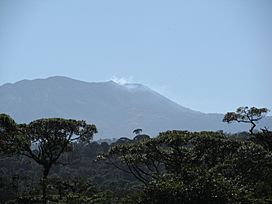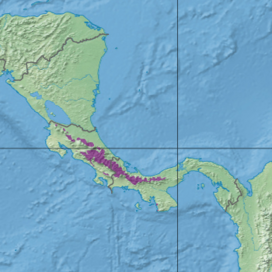Talamancan montane forests facts for kids
Quick facts for kids Talamancan montane forests |
|
|---|---|

Forests around the Turrialba Volcano in Costa Rica
|
|

Ecoregion territory (in purple)
|
|
| Ecology | |
| Realm | Neotropical |
| Biome | tropical and subtropical moist broadleaf forests |
| Borders | Costa Rican seasonal moist forests, Isthmian-Atlantic moist forests, and Isthmian-Pacific moist forests |
| Geography | |
| Area | 16,300 km2 (6,300 sq mi) |
| Countries | Costa Rica and Panama |
| Conservation | |
| Conservation status | Relatively stable/intact |
| Protected | 62%% |
The Talamancan montane forests are a special type of forest found in the mountains of Costa Rica and western Panama. These forests are part of a larger group called tropical and subtropical moist broadleaf forests, which means they are warm and wet all year round. They are located in Central America and are known for their amazing variety of plants and animals.
Contents
Where are the Talamancan Montane Forests Located?
The Talamancan montane forests cover a large area of about 16,300 square kilometers (6,300 square miles). They are spread across several mountain ranges. These include the Cordillera de Guanacaste, Cordillera de Tilarán, Cordillera Central, and Cordillera de Talamanca. You can find them from northwestern Costa Rica all the way to western Panama. There are also smaller parts of these forests on Cerro Hoya in Panama.
These mountain forests grow at high elevations. They start from about 750 to 1,500 meters (2,460 to 4,920 feet) above sea level. They can reach up to 3,000 meters (9,840 feet) high. Above this height, the forests change into grasslands and shrubs. These higher areas are known as the Costa Rican páramo.
The montane forests are surrounded by other types of forests at lower elevations. On the Atlantic (Caribbean) side, you'll find the Isthmian-Atlantic moist forests. To the south, on the Pacific side, are the Isthmian-Pacific moist forests. To the northwest, there are the Costa Rican seasonal moist forests.
What Plants Grow in the Talamancan Forests?
The Talamancan montane forests are full of evergreen trees. This means their leaves stay green all year. Many trees belong to the laurel family (Lauraceae). Examples include Ocotea, Persea, Nectandra, and Phoebe. There are also two types of oak trees found only here: Quercus costaricensis and Quercus copeyensis.
In the northern mountains, laurel trees are the most common tall trees. In the southern Cordillera de Talamanca, oak trees are more common in the higher parts of the forest.
Amazing Plant Diversity
These forests are incredibly rich in different plant species. Many of these plants are endemic, meaning they are found nowhere else in the world. The Cordillera de Talamanca alone is home to about 90% of all plant species found in Costa Rica. More than 30% of all plant species in this ecoregion are endemic. For plants in the high mountains, over 50% are unique to this area.
Forest Layers
The forests have different layers based on their elevation:
- Lower Montane Forests: These grow above 750 meters (2,460 feet) on the Atlantic side. On the Pacific side, they start at 1,500 meters (4,920 feet). They extend up to 2,300 meters (7,550 feet) high.
- Upper Montane Forests: These forests are found from about 2,300 meters (7,550 feet) up to 3,300 meters (10,830 feet).
- Subalpine Dwarf Forests: At the very top, there's a belt of smaller, dwarf trees. This area acts as a bridge between the tall montane forests and the high-elevation grasslands called páramo.
In the lower montane forests, laurels and oaks are the main tall trees. They can grow up to 40 meters (130 feet) tall. Quercus copeyensis is a very common oak. Other common trees include Mollinedia viridiflora and Trichilia havanensis. The lower layers of the forest have dwarf palms like Geonoma hoffmanniana and Chamaedorea warscewiczii. You can also find bamboo like Aulonemia viscosa.
In the upper montane forests, evergreen oaks are the most common trees. Quercus costaricensis is the main type. In the Cordillera de Talamanca, oaks make up 80% of the tall trees at 2,650 meters (8,700 feet). Other trees here include Sciodaphyllum pittieri and species of Magnolia. The forest floor has many smaller trees and shrubs. These include Rhamnus oreodendron and Drimys granadensis. The dwarf bamboo Chusquea talamancensis grows very thick, up to 6 meters (20 feet) tall. Other plants include ericoid shrubs and bromeliads. Near the very top of the forest, you might see Comarostaphylis arbutoides growing densely.
What Animals Live in the Talamancan Forests?
The Talamancan forests are home to many different animals.
Mammals
In the Costa Rican part of the ecoregion, there are 136 different kinds of mammals. The Panamanian part has 84. Some of the well-known mammals include the powerful jaguar and cougar. You can also find tapirs, deer, and anteaters. Several species of monkeys also live here. The Talamancan oryzomys (a type of mouse) is found only in this ecoregion.
Birds
Birds are also very common in these forests. The Costa Rican side has 450 bird species, while the Panamanian side has 225. Some special birds that are threatened in other areas can be found here. These include the beautiful resplendent quetzal, the black guan, the sulphur-winged parakeet, the three-wattled bellbird, and the bare-necked umbrellabird. The huge harpy eagle can be found in the Panamanian region.
This ecoregion is known as an "endemic bird area." This means many bird species live only here. Some of these unique birds include:
- Talamanca hummingbird
- Fiery-throated hummingbird
- White-bellied mountaingem
- Purple-throated mountaingem
- Black-bellied hummingbird
- Yellow-green brushfinch
- Buff-fronted quail-dove
- Black-breasted wood quail
- Costa Rican pygmy owl
- Orange-bellied trogon
- Prong-billed barbet
- Sulphur-winged parakeet
- Silvery-fronted tapaculo
- Ruddy treerunner
- Bare-necked umbrellabird
- Black-capped flycatcher
- Yellow-winged vireo
- Silvery-throated jay
- Ochraceous wren
- Timberline wren
- Black-faced solitaire
- Sooty thrush
- Black-and-yellow silky-flycatcher
- Long-tailed silky flycatcher
- Golden-browed chlorophonia
- Sooty-capped bush tanager
- Sooty-faced finch
- Yellow-thighed finch
- Large-footed finch
- Volcano junco
- Wrenthrush
- Flame-throated warbler
- Black-cheeked warbler
- Collared whitestart
- Black-thighed grosbeak
- Blue-and-gold tanager
- Spangle-cheeked tanager
- Peg-billed finch
- Slaty flowerpiercer
- Dusky nightjar
Amphibians
At least 7 species of amphibians are found only in the Cordillera mountains. These include the colorful splendid poison frog, the Chiriquí fire salamander, and the Cordillera Talamanca salamander.
How are the Talamancan Forests Protected?
The Talamancan montane forests are one of the most untouched ecoregions in Central America. This means they are still largely wild and healthy. However, some oak forests have been cut down for cattle pastures and to make charcoal.
Luckily, a large part of this ecoregion is protected. About 62% of the area is safe within national and international parks. These parks help keep the forests and their animals safe. Some of these important protected areas include:
- La Amistad Biosphere Reserve
- Chirripó National Park
- Barbilla National Park
- Braulio Carrillo National Park
- Volcán Poás National Park
- Irazu Volcano National Park
- Volcán Barú National Park
- Cerro Hoya National Park
- Rincón de la Vieja National Park
- Monteverde Cloud Forest Reserve
Images for kids
-
Myiozetetes similis in Sarapiquí, Costa Rica
-
Bolitoglossa cathyledecae in Chiriquí Province, Panama
See also
 In Spanish: Bosques montanos de Talamanca para niños
In Spanish: Bosques montanos de Talamanca para niños



